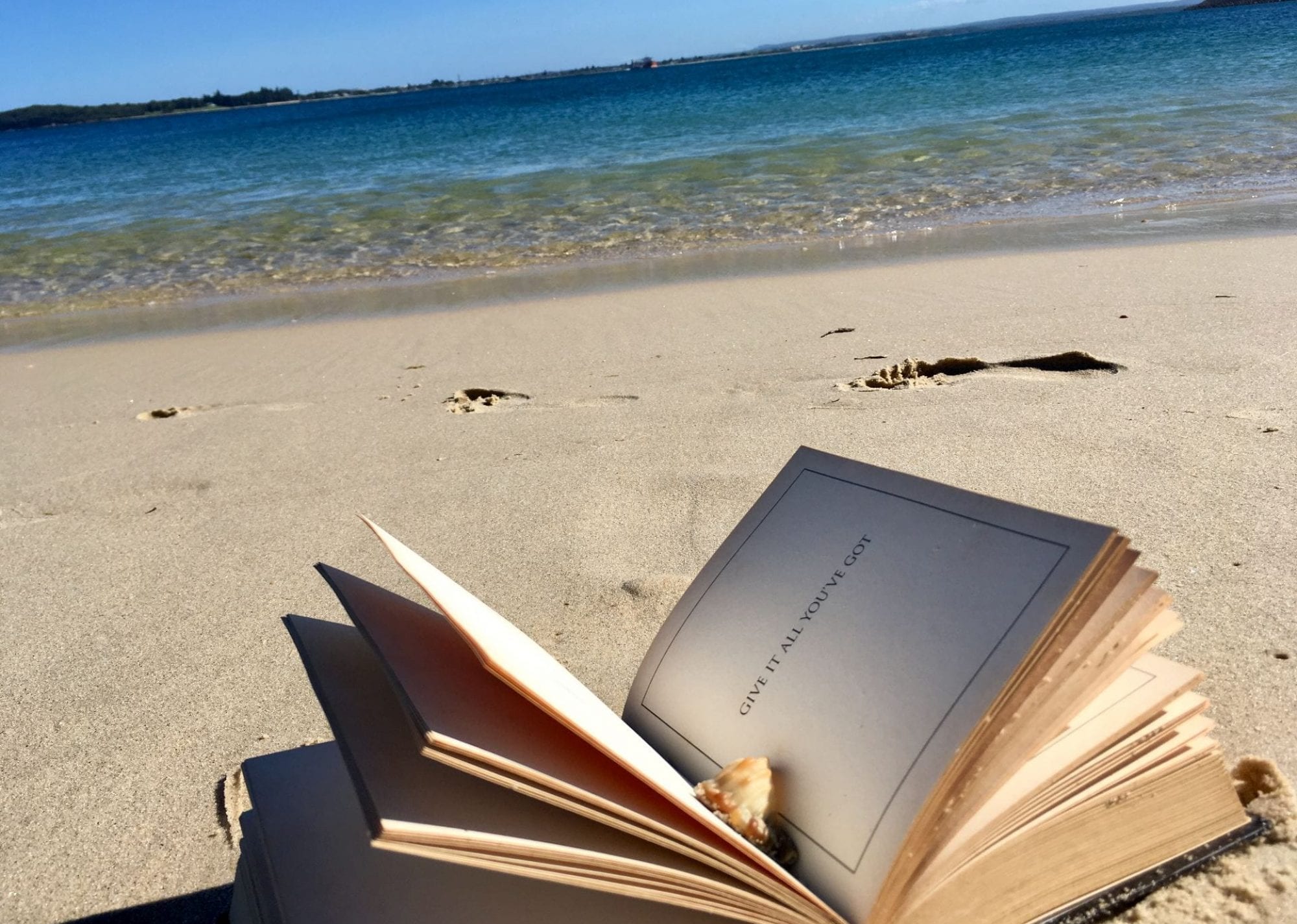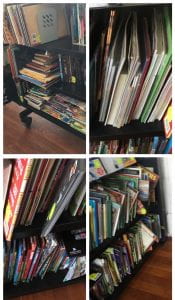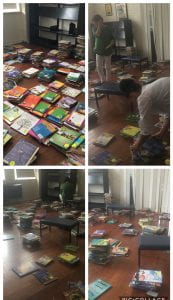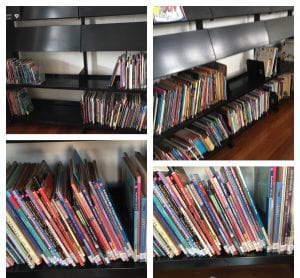ETL 503 – Current acquisitions. Time for change!
Currently there are no policies or procedures in place in my school library as there has been no qualified librarian for years, only temp teachers ‘seat warming’ (their words- not mine). The school has relied heavily on community donations, fund raisers, standing orders, and the librarian buying resources as needed and claiming costs back. I was fortunate in my first term to have the P&C donate funds for me to do a bulk purchase to enable me to weed some existing resources and purchase some new ones. The students were the priority for this injection of books to spark enthusiasm for reading and a wish list from students was created and debated. I was given the responsibility of final decisions and purchases.
The next phase will be a teacher’s wish list and a thorough examination, especially our current non-fiction collection to identify gaps in curriculum supporting material. Collaboration with the teaching staff will be essential in appropriately growing our collection.
Moving forward I would most definitely want to tighten up the procedures around acquisition and develop a collection management policy that reflects the schools needs.
ETL 503 – Types of Budgets
Debowski (2001) raises the key points around responsibility when budgeting for a collection. Who is responsible for developing and submitting the budget and who ultimately is responsible for the spending? Both of these rely heavily on the school context. Whether the TL has the responsibility or the library committee would depend upon whether school even has a library committee (my school does not) so currently the responsibilities of budget and spending lie with myself. Consultation and collaboration with teachers and stakeholders is vital in both areas to ensure the library is adequately funded and resourced so that it services the whole school community and is reflective of their needs and purpose.
References
Debowski, S. (2001). Collection program funding management. In K. Dillon, J. Henri & J.McGregor (Eds.). Providing more with less: collection management for school libraries (2nd ed., pp. 299-326). Wagga Wagga, NSW : Centre for Information Studies, Charles Sturt University. Retrieved from https://doms.csu.edu.au/csu/file/b9feaf8b-3c64-48cf-a5f2-ba87f023bc47/1/debowski-s.pdf
ETL503 – Collaborator, Steward, Thinker
Lamb and Johnson (2012) first set the scene by asking us to think about the library and gather information about its current state and the investment to date. I think and look around the library that I have just inherited and answer these questions:
Does it look inviting/comfortable? – NO we don’t even have chairs/seats for kids to sit on. No air-con so in summer temps in the library were out of control. Big windows with no blinds to keep the sun out. I have since ordered blinds so hopefully will arrive before next summer.
Is it drab? – NO it has had a fresh lick of paint before I arrived – just vanilla but better than dirty and dark.
Dusty/ disintegrating? – YES every surface has layers of dust cracks in walls and continual building works makes it impossible to keep on top of right now. Have library monitors on cleaning duties. Books are dirty and dusty and as a result many ruined, and I have since weeded. I am in the process of getting dust covers added to existing shelving to assist with the issue.
Despite it not being the most inviting place at the moment students still flock to the library at lunchtime to hang out. The students and myself are currently working on new fresh designs to make the space more attractive and functionable.
Now is the time for my school’s library to turn around, not just have a face-lift. A considerable amount of money needs to be spent and spent wisely. Quite a daunting task for me as I am so new. The subject content of ETL 503 is invaluable right now to my success in transforming the library and becoming an effective budget manager.
Lamb and Johnson (2012) point out that a good budget manager does not need to be a ‘maths whiz’. Good thing as I am far from that, but they present three key roles for the teacher librarian to focus on when budgeting; collaborator, steward and thinker.
Collaborator: This for me has already begun.
I have introduced myself presented to the P&C securing funds for new books to improve the current collection and an interactive CommBox is on the way also as a result of the meeting. Future presentations will be focused on acquiring more technology as currently we only have 12 barely functioning laptops.
Students are involved in the new design process, quotes are currently underway for future focused furniture.
I have reached out to other librarians who have assisted in the weeding process of the entire collection. I have sort advise for new resources and ideas on how to improve the physical space of the library.
Steward: This for me I am currently finding most challenging
The principal has allocated me a budget for the library’s physical upgrade and having the confidence to spend this is daunting. Presenting myself as an ‘expert’ in this area when I am just beginning is a tall order but I am documenting my process, making all moves transparent and collaborating with all stakeholders to make credible decisions.
Thinker: Constantly being resourceful
I am currently viewing my library as being a space that needs improvement and can be built upon. I am not looking to throw all things out and start over but as Lamb & Johnson (2012) suggest am ‘making the most of what is available’. I am consulting with the school and parent community, making connections that can assist with what we need. I am prioritising what needs to be addressed and looking into fund raising activities to fund future library resources and equipment.
References:
Lamb, A. & Johnson, H.L. (2012). Program administration: Budget management. The School Library Media Specialist. Retrieved from http://eduscapes.com/sms/administration/budget.html.
ETL 503 – Fiction vs. Non-Fiction
Current literature surrounding resources used within classrooms and libraries suggests a tension between fiction and non-fiction texts (Mosle, 2012). From my personal experience, I have found that in the two schools I have worked at so far the teachers use the library and its resources very differently. My first school relied heavily upon the non-fiction collection to support Science, History, Geography, STEM & Projects and teachers were always visiting the library and asking for advise when it came to choosing quality picture books and fiction to support their reading and writing programs. At my new school teachers do not seem to use non-fiction (from the library anyway) to support subjects taught in class. I gathered war and parliament books for the stage 3 teachers last term in the lead up to them visiting Canberra for their camp but they were not interested in taking them. Teachers especially in K-2 are very interested however in fiction for their reading and writing programs.
School culture and habits I think play a role in how teachers use the library and favour either fiction or non-fiction. It is my job to have them see the value in both so that they use them interchangeably to support all key learning areas to engage and inform their students.
References:
Mosle, S. (2012, November 22). What should children read? The New York Times. Retrieved from https://opinionator.blogs.nytimes.com/2012/11/22/what-should-children-read/?_r=0
A Slow Journey: A room full of books to a library
Having just taken over as librarian at a new school I have inherited a room full of books and have been working tirelessly at transforming it. First the weeding process, organising and then purchasing new resources. My first two subjects ETL401 & ETL503 have been most helpful and I am putting theory into practice which is satisfying.
1. Non-Fiction books shelved every which way with no spine labelling
2. All books removed from shelves, ordered in piles then weeded. There were 35 books on Noah’s Ark & it is not even a Catholic school????
3. Remaining books returned to shelves and spine labelled.
Major weeding and organisational achievements included:
- Removed all big books
- Removed all computer software
- 600 dictionaries/thesaurus removed
- Removed ‘classroom reading boxes’ from Library system
- Weeded ¾ teacher reference materials
- Novel Sets (Resource Boxes) re-classified from Library Resources to School Resources
- Spine labelling
Next step is to secure funds from the P&C and purchase new books. Students and teacher input will be sort when deciding upon new resources.
An ongoing challenge for me will be to not only transform the library’s physical space and upgrade the collection but to change the perception of my role from being one that is quite separate to the rest of the teaching staff. The library is in a location that is not central to classrooms or communal gathering spaces which also I suspect contributes to this perception.
Hartzell (2002) refers to teacher librarian’s “occupational invisibility” and Loertscher (2017) reminds us that it is essential for school teacher librarians to keep up to date with new technologies and trends and to demonstrate “indispensability” to key stakeholders to be considered relevant amongst the school community. Both of these observations being at the forefront of my mind as I develop my profile in the school.
References
Hartzell, G. (2012). The principal’s perceptions of school libraries and teacher-librarians. School libraries worldwide. 8(1).92.
Loertscher, D. (2017). Microdocumentation of the impact of teacher librarians on teaching and learning. Teacher Librarian 44(5), 44-7.
ETL503 – Brewster Kahle: A free digital library
After the Shatzkin discussions I came across this TED Talk.
I can imagine how this would make several authors and publishers nervous.
ETL503 – Thoughts on Shatzkin article
Reading this article by Shatzkin (2016) was a great way to launch into this subject. Learning the historical context surrounding publishing was insightful and will I’m sure be in my thinking from now on when I use a search engine and purchase books. I, for one buy online and off the shelves but personally love to ‘discover’ in a bricks and mortar store. Online search engines allow me to find things when I have an idea of what I’m looking for but lots of times I don’t. It’s those accidental treasures I find when meandering around the shelves of a store that often make the most impact. A cover might catch my eye or a staff members book review might draw me in.
I would hope that there will remain a place for both of these styles of book acquisition in the future. I believe the school library needs to adapt and change with the environment and therefore should offer alternate modes of ‘discovery’ for children. Schools are increasingly using companies such as Wheelers to stock eBooks for students and it will be a challenge for librarians moving forward to keep the shelves a place where bound pages spark curiosity and wonder in their students.
Shatzkin, M. (2016). Book publishing lives in an environment shaped by larger forces and always has. The Shatzkin Files. Retrieved from http://www.idealog.com/blog/book-publishing-lives-in-an-environment-shaped-by-larger-forces-and-always-has
Fresh Start
Hello to everyone embarking on the TL study. I last studied 11 years ago and am looking forward to what lies ahead. This will be a steep learning curve as I’ve never ‘blogged’ before and am of the rare species that does not use Facebook or Instagram (gasp). I currently work in an Inner West Primary school and have made a shift from classroom teacher to Librarian. I feel like I have put the horse before the cart by not doing this degree prior to taking on the role but also think by doing it this way, myself and the school library will be evolving simultaneously as the course progresses which excites me.



